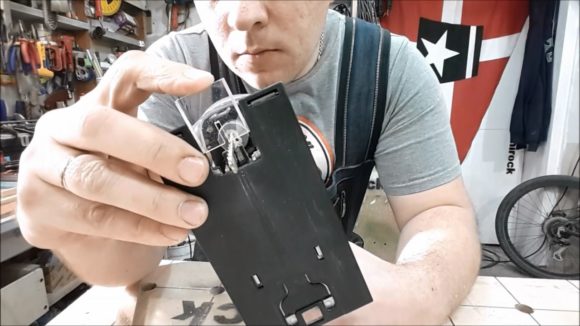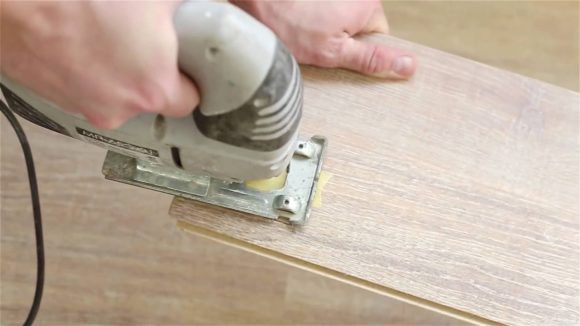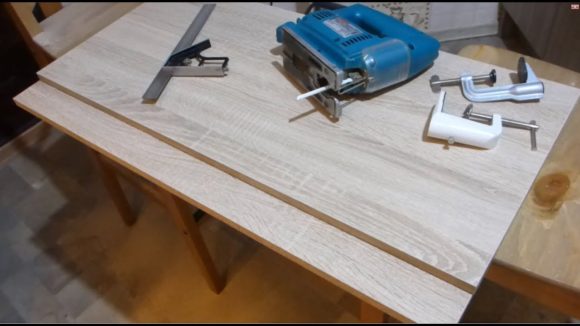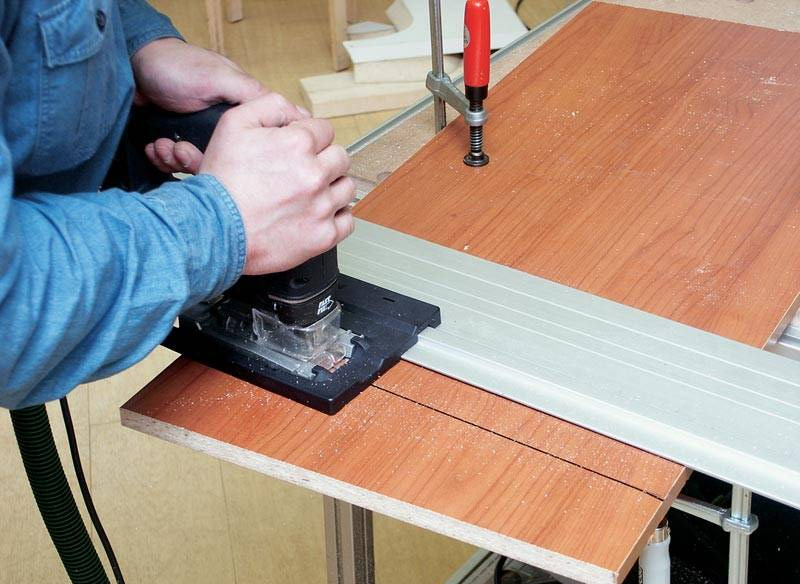The real owner must have installation tools and be able to use them. One of those most important tools is a jigsaw. Often when working with it there are chips. To avoid this, you need to deal with the causes of chips, ways of working with a jigsaw on various materials, read tips on finalizing the tool for high-quality cutting.
Content
Causes of Chipping
If you observe the process of occurrence of cleavage, you can find a pattern: when sawing from top to bottom, the teeth of the file do not saw the material and do not form chips, leaving it. When the process goes from bottom to top, the teeth cling and form kinks.
In the wood material, the fibers located in the neighborhood catch on, and in the chipboard - the coating and chips. If you try to saw two layers of chipboard at the same time, then the layer located below will be sawn qualitatively, since the layer on top counteracted the formation of chips.
Increasing the accuracy of processing will provide the option "Soft start", in which the jigsaw gradually picks up speed, and the cut itself passes as expected. Move the tool slowly. It is necessary to continuously visually monitor the position of the cut point and marking.
Ways to work with a jigsaw without chips on various materials
The jigsaw is suitable for processing a large number of products (wood, metal, tin, plastic surfaces). For each type, there are specific methods and settings of the tool: a certain stroke frequency, pressure force, smooth movement of the device.

Wooden canvas
When choosing a file, remember that the tree needs to be cut with standard tools (with teeth up). The size of the teeth is average, and the step interval is from two and a half to four millimeters. The length of the file depends on the thickness of the sawed surface.
The stroke frequency must be set to the maximum value. It is necessary to reduce it if the material has a tendency to overheat or when working you feel inconvenience. To increase the cutting speed you need to use the pendulum function. The sawing quality is reduced, but this option significantly reduces the operating time, if you do not have so much.
In the process, it is necessary to carry out all operations on the back of the canvas in order to avoid damage. Markup must be done in advance. When sawing begins, it is necessary to press the jigsaw to the blade and slowly control the direction of its progress. Do not push the tool, as it will independently move along the canvas.
Laminate and particleboard
When choosing a file, you need to focus on such a variety as a reverse cut file. Even with a characteristic vibration of this type, the level of quality of the result will not be reduced. Using an ordinary file, it is necessary to carry out an operation on the back of the canvas.
The stroke frequency, as in the previous paragraph, should be maximum. To avoid the formation of chips, the pendulum mechanism should be turned off. In the process, the jigsaw should be firmly pressed and gradually run along the blade (you do not need to press the tool strongly).
Chips occur on the side facing the tool. In this regard, when using a conventional file, you need to determine the front side in advance and make a cut on the back.In addition, you can purchase a special anti-splinter liner - a small element with a cut, which is inserted into the appropriate guides in the sole. The best version of the liner can be considered the option with exactly the corresponding saw cut thickness.
Metal
When choosing a file for metal, you should give preference to options with small teeth, the pitch of which should be in the range from one to two millimeters. The stroke rate should be set to the lowest possible mark. The "pendulum" must be disabled.
When using it is not necessary to press the tool, and it needs to be moved smoothly. The sheet itself should be fixed, while placing its cut line as close as possible to the support. Be sure to take short breaks and use a cooling system to prevent overheating of the tool.
If it is necessary to make a curved cut on a thin tin sheet and place a cut line tightly to the support, metal should be placed between two sheets of fiberboard. In this case, it is necessary to mark exactly the upper fiberboard layer, since this will prevent the formation of a burr.
Plastic
Choosing a nail file with a small clove is worth it, as this will increase the quality of work. Adjust the jigsaw should be based on the variety of plastic. The evenness of the cut will provide a minimum indicator or the complete absence of the pendulum stroke. The stroke frequency should be no more than 40% of the maximum value.
Tile
It is necessary to prepare a file without teeth and apply an abrasive to it. The pendulum stroke must be turned off, the speed reduced to the minimum. In this case, an electric jigsaw is one of the effective devices for cutting curved elements on a tile.
Tinplate
For easy cutting of tin material, you need to attach it tightly. Lay the canvas from the edge of the workbench or place it on the backing. In this case, the cut line should be at the smallest distance from the intended support. It is necessary to crush the material with a timber, so that nothing would hamper the freedom of movement of the jigsaw.
“Swap” should be set to “0” or “1”. The file used should be provided exclusively for metal. If the blade being processed has a thickness of more than two millimeters, then it is better to lubricate the place of cut with oil (for machines). For a good result, the tin cloth needs to be laid between thin plywood. This will make it possible to work far from the support line, which is important in conditions of curvilinear cutting.

Adhesive tapes
Adhesive tape (for example, ordinary adhesive tape) is the protection of the back of the material. It is necessary to stick on the cut line a tape that keeps the workpiece from breaking off large elements. Masking tape cannot be called a very effective option for preserving the material when cutting with a jigsaw, since its strength is extremely low.
A wide enough (each side of the cut material should be covered by at least fifteen centimeters) aluminum or reinforced fiberglass tape is best suited. In addition, the adhesive tape must be pressed with a dry cloth to eliminate the risk of wrinkles.
Refinement of the jigsaw sole
When adjusting the jigsaw, you must first check the perpendicularity of the sole, as sometimes the clamp is not fixed firmly. Specialists often modify the sole of the tool, that is, reduce the gap between the leg and the pressure pad. This eliminates the “breaking” of the crust in the layers of material on top.
Using pads, it is important for every novice master to remember that they should not scratch the surface of the part. In this case, they must be replaced every five meters of cutting. Zero clearance can be achieved by fixing the patch plate to the base leg of the jigsaw.
The lining has only one narrow slot that fits snugly against the cutting element.Therefore, even a weak supply of teeth can cut off small chips, and not turn out chips of the upper layer. The most high-quality linings that are guaranteed to last you a long time are usually made of:
- plastic sheet;
- metal material;
- fiberglass.
Providing a clean cut
In many cases of processing the material, the size of the chips can be reduced to half a millimeter. Such not-so-significant shortcomings are not striking, they can be removed by chamfering with emery or by coating the chips with a correcting pencil. It is also possible to polish the end face with emery cloth or cut through the canter with the upper layer of the surface.
First, make 2 cuts half a millimeter deep on both sides of the part, indicating the thickness. Two grooves should be noted along the edges of the cut, which can be done using a slanting shoe or a segment knife (for wood without coating or chipboard), or using a sharp drill and a victory cutter (for a laminate).

Correction of Chips
Cutting off the material with an electric jigsaw and avoiding chips is practically impossible. You can do this: cut the part with an electric jigsaw with a small allowance (2 mm in size), and then mill or grind the allowance with a belt grinder. When milling, the edge is cleaner than when working with a grinder. Usually, the material is milled on a tire (made on the basis of a circular saw tire). Spiral milling cutters will improve the quality of milling. It is necessary to prepare them in the amount of two pieces.
If you want one front to remain clean, you need to use an ordinary two-way mill. If both clean sides are needed, then it is worth using a four-way milling cutter with two main branches having a left direction and two cutting branches with a right direction. Then it turns out that when cutting the material, the upper branches press the material down, and the lower ones pull it up. This prevents chipping at the edges.





Alas, no comments yet. Be the first!